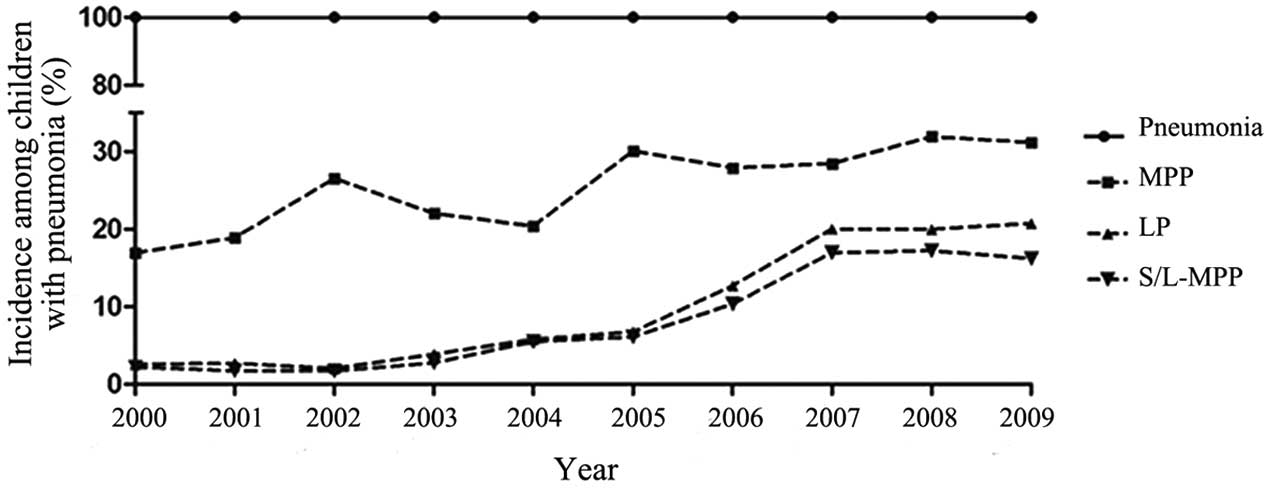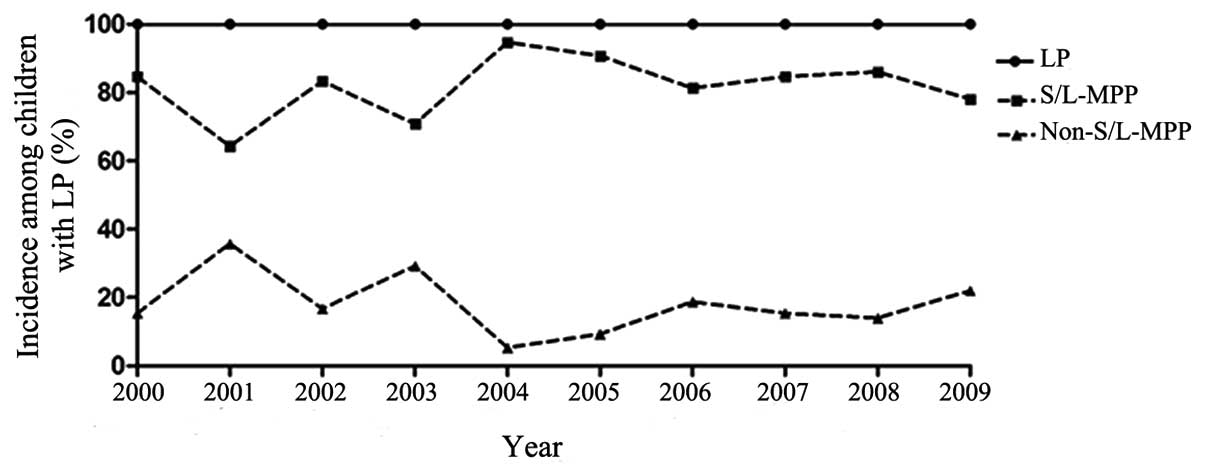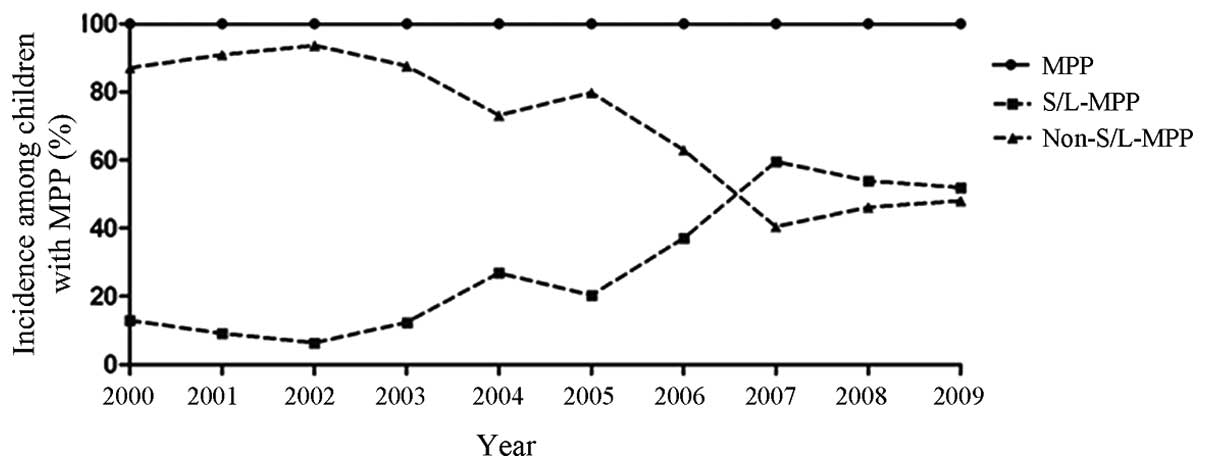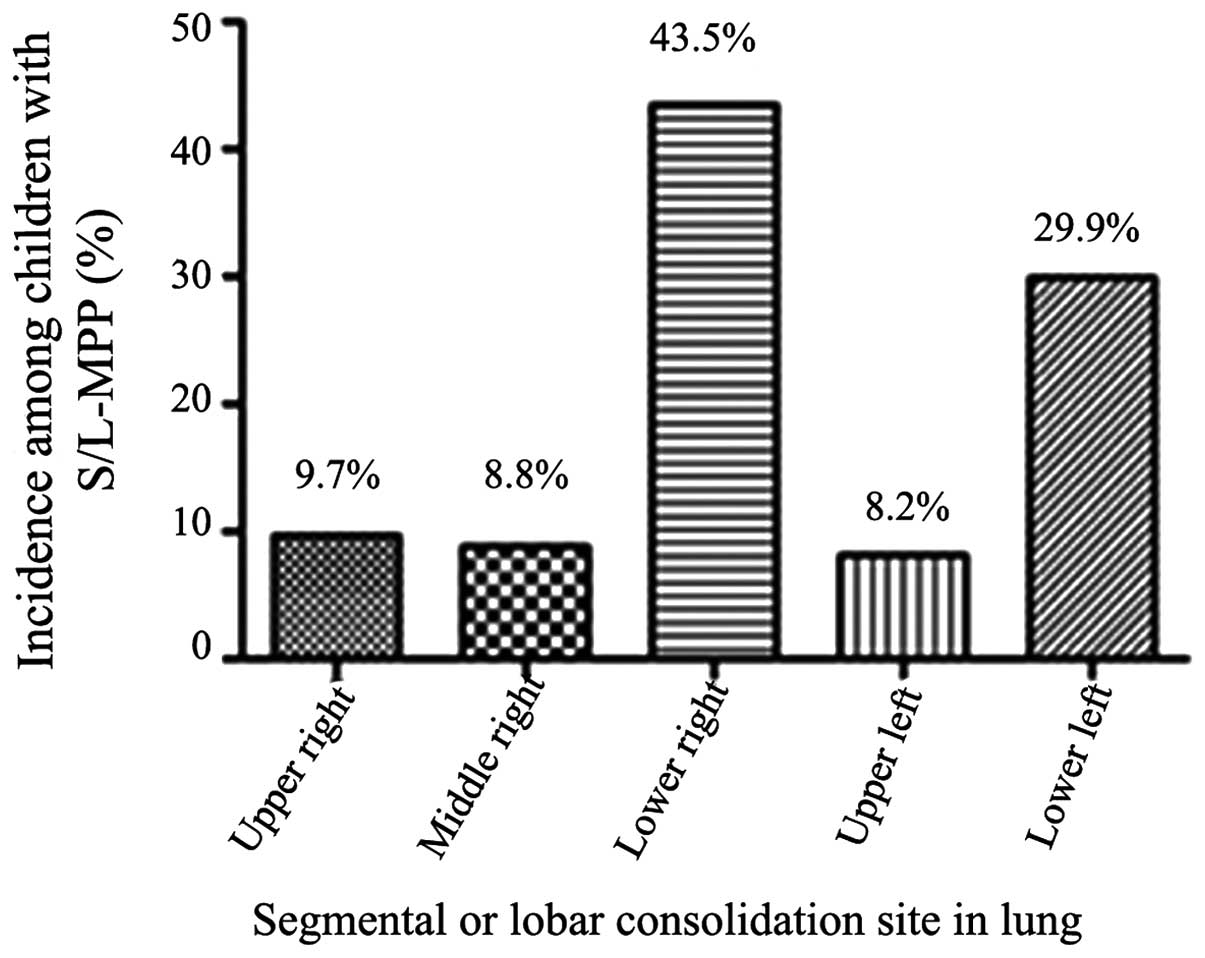|
1
|
Foy HM: Infections caused by Mycoplasma
pneumoniae and possible carrier state in different populations of
patients. Clin Infect Dis. 17(Suppl 1): S37–S46. 1993. View Article : Google Scholar : PubMed/NCBI
|
|
2
|
Marston BJ, Plouffe JF, File TM Jr,
Hackman BA, Salstrom SJ, Lipman HB, Kolczak MS and Breiman RF: The
Community-based Pneumonia Incidence Study Group: Incidence of
community-acquired pneumonia requiring hospitalization: Results of
a population-based active surveillance study in Ohio. Arch Intern
Med. 157:1709–1718. 1997. View Article : Google Scholar : PubMed/NCBI
|
|
3
|
Waites KB and Talkington DF: Mycoplasma
pneumoniae and its role as a human pathogen. Clin Microbiol Rev.
17:697–728. 2004. View Article : Google Scholar : PubMed/NCBI
|
|
4
|
Liu G, Talkington DF, Fields BS, Levine
OS, Yang Y and Tondella ML: Chlamydia pneumoniae and Mycoplasma
pneumoniae in young children from China with community-acquired
pneumonia. Diagn Microbiol Infect Dis. 52:7–14. 2005. View Article : Google Scholar : PubMed/NCBI
|
|
5
|
Heiskanen-Kosma T, Korppi M, Jokinen C,
Kurki S, Heiskanen L, Juvonen H, Kallinen S, Stén M, Tarkiainen A,
Rönnberg PR, et al: Etiology of childhood pneumonia: Serologic
results of a prospective, population-based study. Pediatr Infect
Dis J. 17:986–991. 1998. View Article : Google Scholar : PubMed/NCBI
|
|
6
|
Phares CR, Wangroongsarb P, Chantra S,
Paveenkitiporn W, Tondella ML, Benson RF, Thacker WL, Fields BS,
Moore MR, Fischer J, et al: Epidemiology of severe pneumonia caused
by Legionella longbeachae, Mycoplasma pneumoniae and Chlamydia
pneumoniae: 1-year, population-based surveillance for severe
pneumonia in Thailand. Clin Infect Dis. 45:e147–e155. 2007.
View Article : Google Scholar : PubMed/NCBI
|
|
7
|
Korppi M, Heiskanen-Kosma T and Kleemola
M: Incidence of community-acquired pneumonia in children caused by
Mycoplasma pneumoniae: Serological results of a prospective,
population-based study in primary health care. Respirology.
9:109–114. 2004. View Article : Google Scholar : PubMed/NCBI
|
|
8
|
Layani-Milon MP, Gras I, Valette M,
Luciani J, Stagnara J, Aymard M and Lina B: Incidence of upper
respiratory tract Mycoplasma pneumoniae infections among
outpatients in Rône-Alpes, France, during five successive winter
periods. J Clin Microbiol. 37:1721–1726. 1999.PubMed/NCBI
|
|
9
|
Principi N and Esposito S: Emerging role
of Mycoplasma pneumoniae and Chlamydia pneumoniae in paediatric
respiratory-tract infections. Lancet Infect Dis. 1:334–344. 2001.
View Article : Google Scholar : PubMed/NCBI
|
|
10
|
John SD, Ramanathan J and Swischuk LE:
Spectrum of clinical and radiographic findings in pediatric
mycoplasma pneumonia. Radiographics. 21:121–131. 2001. View Article : Google Scholar : PubMed/NCBI
|
|
11
|
Nambu A, Saito A, Araki T, Ozawa K,
Hiejima Y, Akao M, Ohki Z and Yamaguchi H: Chlamydia pneumoniae:
Comparison with findings of Mycoplasma pneumoniae and Streptococcus
pneumoniae at thin-section CT. Radiology. 238:330–338. 2006.
View Article : Google Scholar : PubMed/NCBI
|
|
12
|
Reittner P, Muller NL, Heyneman L, Johkoh
T, Park JS, Lee KS, Honda O and Tomiyama N: Mycoplasma pneumoniae
pneumonia: Radiographic and high-resolution CT features in 28
patients. AJR Am J Roentgenol. 174:37–41. 2000. View Article : Google Scholar : PubMed/NCBI
|
|
13
|
Lee I, Kim TS and Yoon HK: Mycoplasma
pneumoniae pneumonia: CT features in 16 patients. Eur Radiol.
16:719–725. 2006. View Article : Google Scholar : PubMed/NCBI
|
|
14
|
George RB, Weill H, Rasch JR, Mogabgab WJ
and Ziskind MM: Roentgenographic appearance of viral and
mycoplasmal pneumonias. Am Rev Respir Dis. 96:1144–1150.
1967.PubMed/NCBI
|
|
15
|
Murray HW, Masur H, Senterfit LB and
Roberts RB: The protean manifestations of Mycoplasma pneumoniae
infection in adults. Am J Med. 58:229–242. 1975. View Article : Google Scholar : PubMed/NCBI
|
|
16
|
Brolin I and Wernstedt L: Radiographic
appearance of mycoplasmal pneumonia. Scand J Respir Dis.
59:179–189. 1978.PubMed/NCBI
|
|
17
|
Defilippi A, Silvestri M, Tacchella A,
Giacchino R, Melioli G, Di Marco E, Cirillo C, Di Pietro P and
Rossi GA: Epidemiology and clinical features of Mycoplasma
pneumoniae infection in children. Respir Med. 102:1762–1768. 2008.
View Article : Google Scholar : PubMed/NCBI
|
|
18
|
Esposito S, Blasi F, Bellini F, Allegra L
and Principi N: Mowgli Study Group: Mycoplasma pneumoniae and
Chlamydia pneumoniae infections in children with pneumonia. Eur
Respir J. 17:241–245. 2001. View Article : Google Scholar : PubMed/NCBI
|
|
19
|
Foy HM, Kenny GE, McMahan R, Mansy AM and
Grayston JT: Mycoplasma pneumoniae pneumonia in an urban area. Five
years of surveillance. JAMA. 214:1666–1672. 1970. View Article : Google Scholar : PubMed/NCBI
|
|
20
|
Youn YS, Lee KY, Hwang JY, Rhim JW, Kang
JH, Lee JS and Kim JC: Difference of clinical features in childhood
Mycoplasma pneumoniae pneumonia. BMC Pediatr. 10:482010. View Article : Google Scholar : PubMed/NCBI
|
|
21
|
World Health Organization Pneumonia
Vaccine Trial Investigators' Group. Standardization of
interpretation of chest radiographs for the diagnosis of pneumonia
in children. http://apps.who.int/iris/bitstream/10665/66956/1/WHO_V_and_B_01.35.pdfAccessed.
November 29–2011
|
|
22
|
Daxboeck F, Bauer CC, Assadian O and
Stanek G: An unrecognized epidemic of Mycoplasma pneumoniae
infection in Vienna. Wien Klin Wochenschr. 118:208–211. 2006.
View Article : Google Scholar : PubMed/NCBI
|
|
23
|
Musatovova O, Kannan TR and Baseman JB:
Genomic analysis reveals Mycoplasma pneumoniae repetitive element
1-mediated recombination in a clinical isolate. Infect Immun.
76:1639–1648. 2008. View Article : Google Scholar : PubMed/NCBI
|
|
24
|
Nolevaux G, Bessaci-Kabouya K, Villenet N,
Andrèoletti L, Laplanche D, Carquin J, Abély M, De Champs C and
Motte J: Epidemiological and clinical study of Mycoplasma
pneumoniae respiratory infections in children hospitalized in a
pediatric ward between 1999 and 2005 at the Reims University
Hospital. Arch Pediatr. 15:1630–1636. 2008.(In French). View Article : Google Scholar : PubMed/NCBI
|
|
25
|
Hong JY, Nah SG, Nam SG, Choi EH, Park JY
and Lee HJ: Occurrence of Mycoplasma pneumoniae pneumonia in Seoul,
Korea, from 1986–1995. Korean J Pediatr. 40:607–613. 1997.
|
|
26
|
Kang KS and Woo HO: Pattern of occurrence
of Mycoplasma pneumoniae pneumonia in admitted children, southern
central Korea, from 1989 to 2002. Korean J Pediatr. 46:474–479.
2003.
|
|
27
|
Principi N, Esposito S, Blasi F and
Allegra L: Mowgli Study Group: Role of Mycoplasma pneumoniae and
Chlamydia pneumoniae in children with community-acquired lower
respiratory tract infections. Clin Infect Dis. 32:1281–1289. 2001.
View Article : Google Scholar : PubMed/NCBI
|
|
28
|
Xu YC, Zhu LJ, Xu D, Tao XF, Li SX, Tang
LF and Chen ZM: Epidemiological characteristics and meteorological
factors of childhood Mycoplasma pneumoniae pneumonia in Hangzhou.
World J Pediatr. 7:240–244. 2011. View Article : Google Scholar : PubMed/NCBI
|
|
29
|
Marrie TJ: Pneumococcal pneumonia:
Epidemiology and clinical features. Semin Respir Infec. 14:227–236.
1999.
|
|
30
|
Toikka P, Juvén T, Virkki R, Leinonen M,
Mertsola J and Ruuskanen O: Streptococcus pneumoniae and Mycoplasma
pneumoniae coinfection in community acquired pneumonia. Arch Dis
Child. 83:413–414. 2000. View Article : Google Scholar : PubMed/NCBI
|
|
31
|
Liu Y, Ye X, Zhang H, Xu X, Li W, Zhu D
and Wang M: Antimicrobial susceptibility of Mycoplasma pneumoniae
isolates and molecular analysis of macrolide-resistant strains from
Shanghai, China. Antimicrob Agents Chemother. 53:2160–2162. 2009.
View Article : Google Scholar : PubMed/NCBI
|
|
32
|
Liu Y, Ye X, Zhang H, Xu X, Li W, Zhu D
and Wang M: Characterization of macrolide resistance in Mycoplasma
pneumoniae isolated from children in Shanghai, China. Diagn
Microbiol Infect Dis. 67:355–358. 2010. View Article : Google Scholar : PubMed/NCBI
|
|
33
|
Ito I, Ishida T, Osawa M, Arita M,
Hashimoto T, Hongo T and Mishima M: Culturally verified Mycoplasma
pneumoniae pneumonia in Japan: A long-term observation from
1979–99. Epidemiol Infect. 127:365–367. 2001.PubMed/NCBI
|
|
34
|
Othman N, Isaacs D and Kesson A:
Mycoplasma pneumoniae infections in Australian children. J Paediatr
Child Health. 41:671–676. 2005. View Article : Google Scholar : PubMed/NCBI
|
|
35
|
Wu PS, Huang LM, Chang IS, Lu CY, Shao PL,
Tsai FY and Chang LY: The epidemiology of hospitalized children
with pneumococcal/lobar pneumonia and empyema from 1997 to 2004 in
Taiwan. Eur J Pediatr. 169:861–866. 2010. View Article : Google Scholar : PubMed/NCBI
|
|
36
|
Cockcroft DW and Stilwell GA: Lobar
pneumonia caused by Mycoplasma pneumoniae. Can Med Assoc J.
124:1463–1468. 1981.PubMed/NCBI
|














